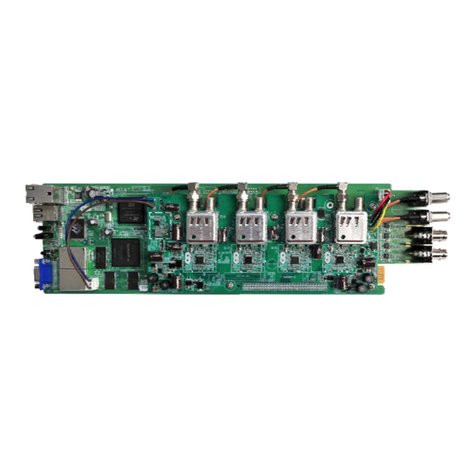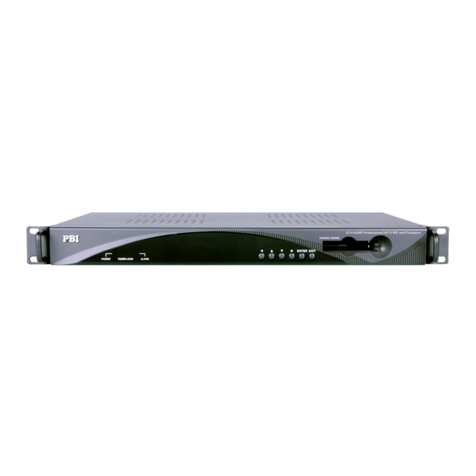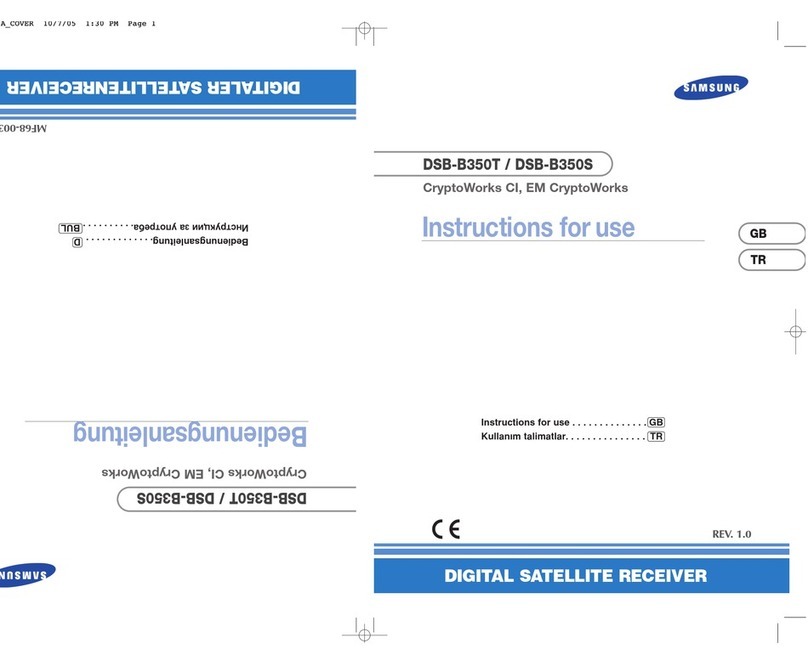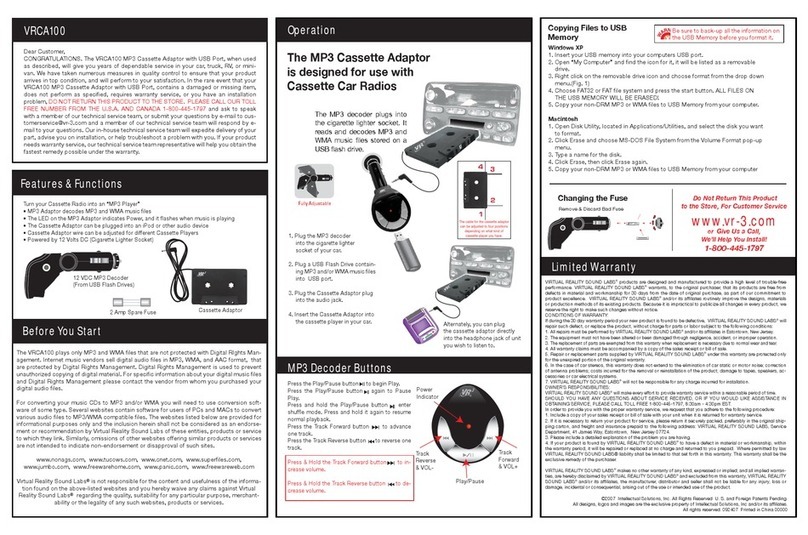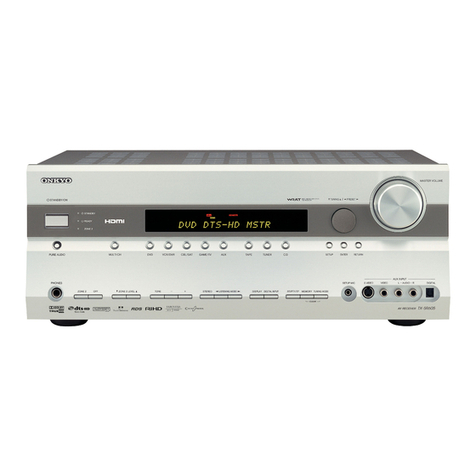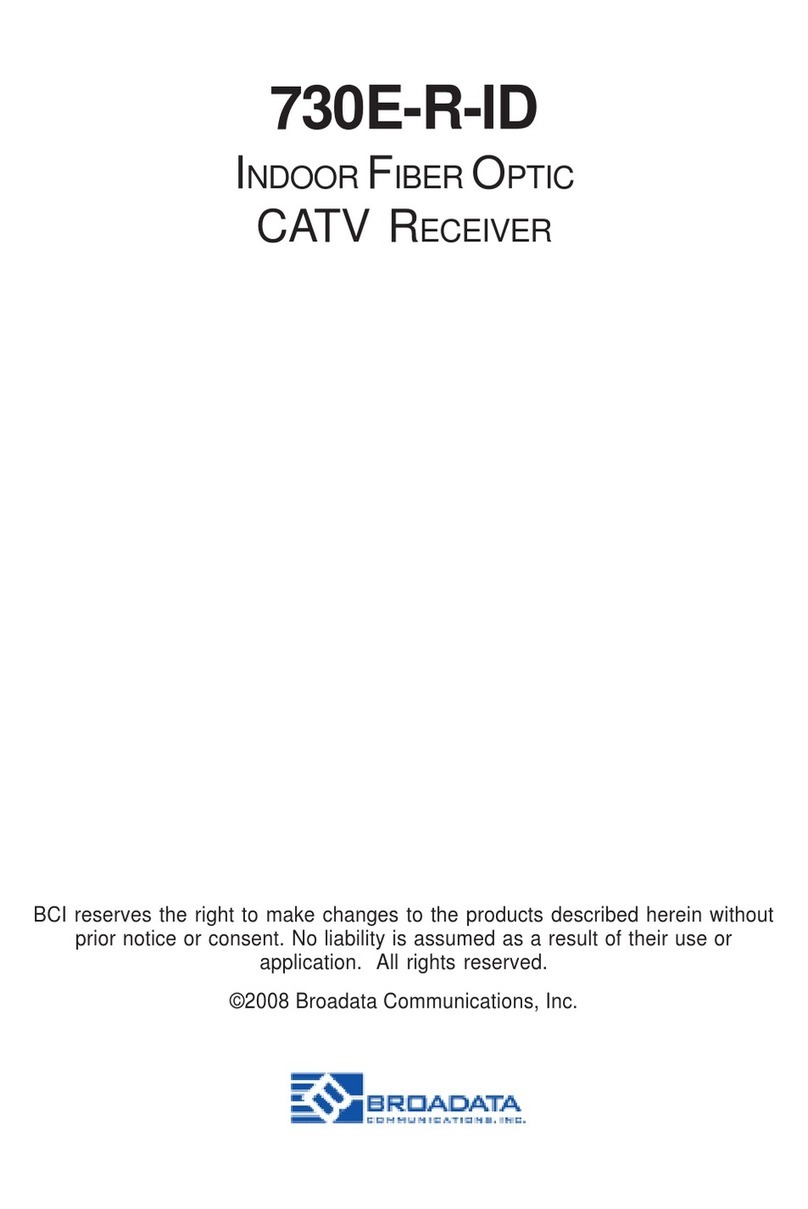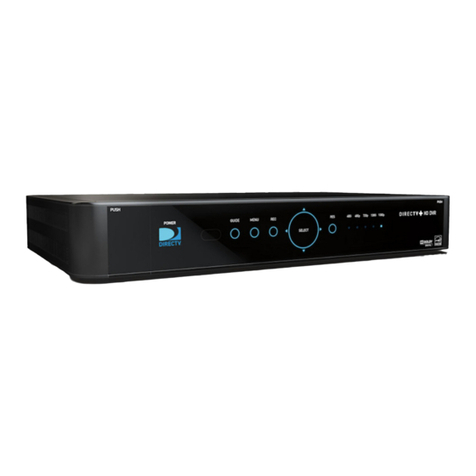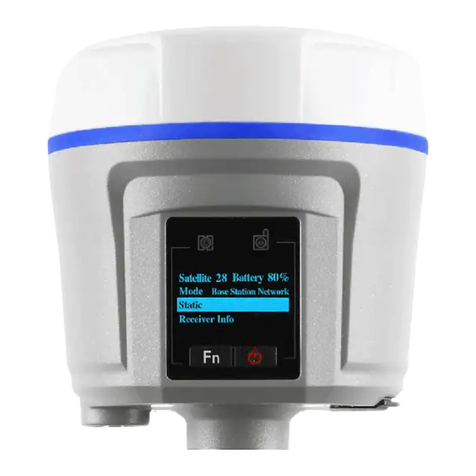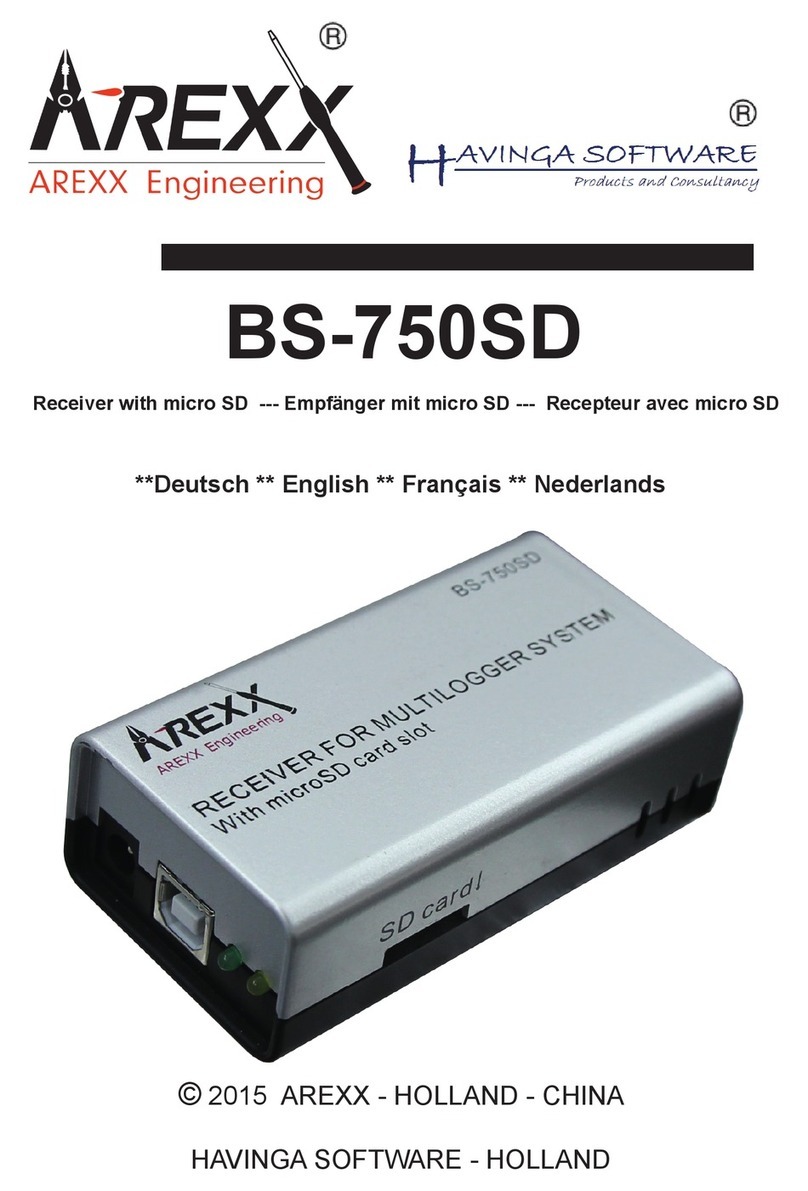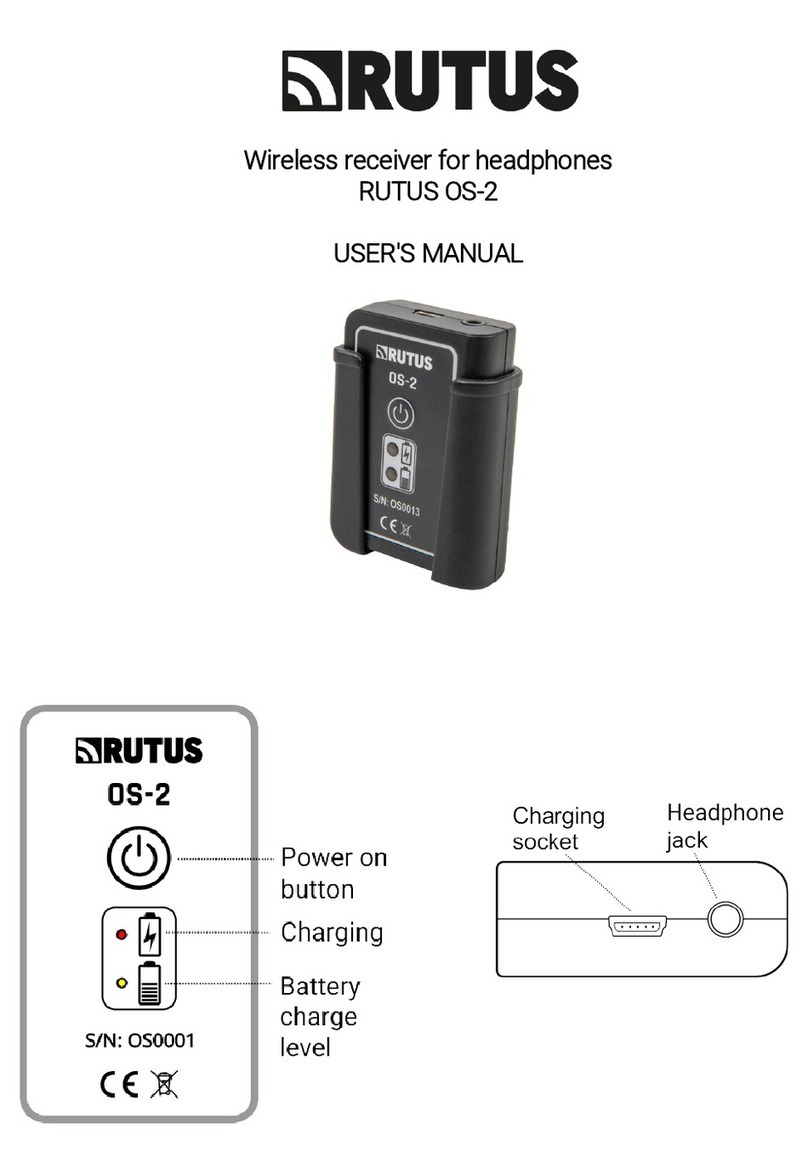PBI DMM-1701PM User manual

DVB Receiver and Twin Analog
Trans-modulator
User Manual
http://www.pbi-china.com

Contents
Notices.......................................................................................................................1
1 Overview.................................................................................................................4
2 Features..................................................................................................................4
3 Technical Specifications .........................................................................................4
4 Order Information....................................................................................................7
5 Front panel and rear panel instructions ..................................................................7
5.1 Front panel ...................................................................................................7
5.2 Rear panel....................................................................................................8
6 Menu Operating Instructions Via DMM-1000CU.....................................................9
6.1 Status .........................................................................................................10
6.2 Cofig...........................................................................................................11
6.3 Network ......................................................................................................12
6.4 System........................................................................................................12
7 Web Control..........................................................................................................13
7.1 Status Page................................................................................................13
7.2 Tuner Page.................................................................................................14
7.3 CI Page.......................................................................................................15
7.4 RF Page .....................................................................................................15
7.5 Decoder-1/2 Page.......................................................................................16
7.6 System Page..............................................................................................18
8 Installation.............................................................................................................21
9 Accessories ..........................................................................................................21

1701PM
- 1 -
Notices
COPYRIGHT (Copyright © 2012 Beijing Jaeger Communication Electronic Technology Co., Ltd.)
Not to be copied, used or translated in part or whole without Beijing Jaeger prior consent in writing
except approval of ownership of copyright and copyright law.
WARRANTY
This warranty does not cover parts which may become defective due to misuse of the information
contained in this manual.
Read this manual carefully and make sure you understand the instructions provided. For your safety,
be aware of the following precautions.
WARNING! IMPORTATNT SAFETY INSTRUCTIONS
CAUTION: TO REDUCE THE RISK OF ELECTRIC SHOCK, DO NOT REMOVE
COVER (OR BACK). NO USER SERVICEABLE PARTS INSIDE. REFER
SERVICING TO QUALIFIED SERVICE PERSONNEL.
WARNING
•To reduce the risk of fire or electric shock, do not expose this apparatus to rain or moisture.
•To avoid explosion danger, do not dispose of batteries in an open fire.
CE MARK FOR EUROPEAN HARMONISED STANDARDS
The CE mark which is attached to these products means it conforms to EMC
Directive (89/336/EEC) and Low Voltage Directive (73/23/EEC).
IMPORTANT INFORMATION
Please retain the original packaging, should it be necessary at some stage to return the unit.
Disposal of Old Electrical and Electronic Equipment (Applicable in the European Union and
other European countries with separate collection systems)
This symbol on the product or on its packaging indicates that this product shall not
be treated as household waste. Instead it shall be handed over to the applicable
collection point for the recycling of electrical and electronic equipment. By
ensuring this product is disposed of correctly, you will help prevent potential
negative consequences for the environment and human health, which could
otherwise be caused by inappropriate waste handling of this product. The
recycling of materials will help to conserve natural resources. For more detailed
information about recycling of this product, please contact your local Civic Office,
your household waste disposal service, or the shop where you purchased the
product.
COPYRIGHTS
Television programs, movies, video tapes, discs, and other materials may be copyrighted.
Unauthorized recording of copyrighted material may be against the copyright laws in your region.
Also, use of this product with cable television transmissions may require authorization from the cable
television operator or transmitter/owner.
VENTILATION
•Do not expose the product to high temperatures, such as placing it on top of other product that
produce heat or in places exposed to direct sunlight or spot lights.
•The ventilation slots on top of the product must be left uncovered to allow proper airflow into the
unit.
•Do not stand the product on soft furnishings or carpets.
•Do not stack electronic equipment on top of the product.
•Do not place the product in a location subject to extreme changes in temperature. The
temperature gradient should be less than 10 degrees C/hour.
•Place the product in a location with adequate ventilation to prevent the build-up of heat inside the
product. The minimum ventilation space around the unit should be 7 cm. The ventilation should
not be impeded by covering the ventilation openings with items, such as newspapers, table cloth,
curtains, etc.

1701PM
- 2 -
POWER SOURCES
•The product is not disconnected from the AC power source (mains) as long as it is connected to
the power outlet or wall socket, even if the product is turned off.
•If the product will not be used for a long period of time, disconnect it from the AC power outlet or
wall socket.

1701PM
- 3 -
Before Using the Device
Thank you for purchasing the DMM-1701PM twin digital to analog trans-modulator. This User Manual
is written for operators/users of the DMM-1701PM to assist in installation and operation. Please read
this user manual carefully before installation and use of the device.
FOR YOUR SAFETY
This equipment is provided with a protective earthing ground incorporated in the power cord. The
main plug shall only be inserted in a socket outlet provided with a protective earth contact. Any
interruption of the protective conductor, inside or outside the device, is likely to make the device
dangerous. Do not remove the covers of this equipment. Hazardous voltages are present within this
equipment and may be exposed if the covers are removed. Only Beijing Jaeger trained and approved
service engineers are permitted to service this equipment.
The supplied AC power cable must be used to power the device. If the power cord becomes
damaged it must be replaced. No operator serviceable parts inside. Refer servicing to Beijing Jaeger
trained and approved service engineers. For the correct and safe use of the device, it is essential
that both operating and servicing personnel follow generally accepted safety procedures in addition
to the safety precautions specified in this manual. Whenever it is likely that safety protection is
impaired, the device must be made in-operative and secured against unintended operation. The
appropriate servicing authority must be informed. For example, safety is likely to be impaired if the
device fails to perform the intended measurements or shows visible damage.
WARNINGS
•The mounting environment should be relatively dust free, free of excessive vibration and the
ambient temperature between 0C°to 40C°. Relative humidity of 20% to 80% (non-condensed) is
recommended.
•Avoid direct contact with water.
•Never place the equipment in direct sunlight.
•The outside of the equipment may be cleaned using a lightly dampened cloth. Do not use any
cleaning liquids containing alcohol, methylated spirit or ammonia etc.
•For continued protection against fire hazard, replace line fused only with same type.
•Air intake for cooling is achieved via holes at the side of the device and the fans inside. The air
flow should not be obstructed. Therefore, the device has to be placed on a flat surface, leaving
some space at the sides of the device.
•When in operation, the internal temperature should not exceed the limit of 70C°.

1701PM
- 4 -
1. Overview
DMM-1701PM is a high performance Digital to analog trans-modulator. With 2
independent built-in decoder, it can decode 2 DVB programs from a tuner port with
MPEG-2\H.264 HD\SD definition, then trans-modulate these 2 programs by built-in
modulators and output a combined signal via RF output port. With its full compliance to
analog standards including PAL, NTCS and SECAM, DMM-1701PM is an ideal deployment
for digital to analog system.
2. Features
◎Support MPEG-2/H.264 HD/SD TS decoding
◎Support various analog TV standards including PAL, SECAM and NTSC
◎Two adjacent analog channels output in range of 48~860Mhz
◎Dynamic PMT detection and automatic updating
◎Support DVB/EBU Subtitle, Teletext, WSS
◎Support dual DVB-CI for multi-decryption, BISS-1, BISS-E descrambling
◎Out level 100dBuV per channel
◎Support SNMP V1/V2, IGMP V2, NTP(Network Time Protocol)
◎Remote control and supervision by SNMP and HTTP web, upgrade via FTP or USB
◎RSSI, received Eb/No & BER monitoring
◎Accommodated in 4RU 19” chassis (DMM-1000MF) which supports up to 8 modules and
equipped with auto-backup Power Supply module.
3. Technical Specifications
DVB-S/S2 Input
Connector Type
1x F Type female, 75Ω(input)
1x F Type female, 75Ω(loop through output)
Input Frequency Range
950 ~ 2150MHz
Input Signal Level
-65 ~ -25dBm
Symbol Rate
DVB-S: 1~45MBauds/s for QPSK
DVB-S2: 1~45MBauds/s for QPSK, 8PSK
Roll-off Factory
DVB-S: 0.35
DVB-S2: 0.2, 0.25, 0.35
Forward Error Correction
DVB-S QPSK: 1/2, 2/3, 3/4, 5/6, 6/7, 7/8
DVB-S2 QPSK: 1/2, 3/5, 2/3, 3/4, 4/5, 5/6, 8/9, 9/10
DVB-S2 8PSK: 3/5, 2/3, 3/4, 5/6, 8/9, 9/10
LNB Control Voltage
0, 13V, 18V adjustable
LNB Tone Switch
0, 22Khz adjustable
DiSEqc
DiSEqc 1.0

1701PM
- 5 -
DVB-T Input
Connector Type
1x F Type female, 75Ω(input)
1x F Type female, 75Ω(loop through output)
Input Frequency Range
48MHz~861MHz
Input Signal Level
-65 ~ -25dBm
Tuner Bandwidth
6MHz, 7MHz, 8MHz
Viterbi Error Correction
2/1, 2/3, 4/3, 5/6, 7/8
Guard Interval
1/4, 1/8, 1/16, 1/32
FFT mode
2K, 8K
DVB-C Input
Connector Type
1x F Type female, 75Ω(input)
1x F Type female, 75Ω(loop through output)
Input Frequency Range
51MHz~858MHz
Input Signal Level
40 ~ 85dBuV
Constellation
16, 32, 64, 128, 256 QAM (ITU J.83 Annex A)
Symbol Rate
1 ~ 7MBaud
RF Output
Connector Type
1x F Type female, 75Ω(primary output)
1x F Type female, 75Ω(-20dB for monitoring)
Output Frequency Range
48MHz agile, step by 10KHz
Carrier Output Level
100±3dBuV
Spurious Rejection
≥55dB
Output Return Loss
10dB
Output Level Attenuation
0~18dB(adjustable)
Chrominance/Brightness
Delay Differential
≤45nS
K2T
≤4%
Video Modulation
Video modulation depth
85%~87.5%
Video in-band flatness
≤2dB
Differential Gain
≤7%
Differential Phase
≤5°
Video SN Ratio
≥45dB
Chrominance/Brightness
Delay Differential
≤45nS
K2T(2T Pulse K factor)
≤4%
Video Carrier Frequency
VHF:△f ≤5KHz
UHF:△f ≤10KHz
Audio Modulation

1701PM
- 6 -
Audio SN Ratio
≥55dB
Audio Pre-emphasis
50μs(B/G, D/K, I), 75μs (M/N)
Audio Frequency Response
±1.5dB (40Hz~15KHz)
Total Harmonic Distortion
≤1.2%
Audio Modulation Deviation
40 ~ 100KHz peak to peak(D/K,B/G,I)
50KHz peak to peak (M/N)
Audio Carrier Frequency(main)
6.5MHz ±5KHz (D/K)
6.0MHz ±5K (I)
5.5MHz ±5KHz (B/G)
4.5MHz ±5KHz (M/N)
Audio Carrier Frequency(second,
Only suitable to A2 Stereo
trans-modulator)
6.742MHz ±5KHz (D/K)
6.258MHz ±5KHz (D/K, Poland)
5.742MHz ±5KHz (B/G)
64.742MHz ±5KHz (M/N)
Control & Monitoring
Connector Type
1×RJ45, 10/100 Base-T, for Web Control
Remote Control
SNMP, HTTP(WEB interface)
Local Control
Handheld Programmer Unit
Software Upgrade
Quick upgrade via USB, or FTP loader
Physical parameter
Dimension
379.7mm *111.5mm *39mm
Weight
610g Net.
Power supply
DC 3.3V/5V/12V, supplied by DMM-1000MF chassis
Power Consumption
30W (Max.)
Operating Temperature
0 ~ 45℃
Storage Temperature
-10 ~ 60℃
Humidity
10 ~ 90%, Non-condensed

1701PM
- 7 -
4. Order Information
DMM-1701PM-xx series
Input type
DVB-S2
DVB-T
DVB-C
Video Audio
MONO
A2
MONO
A2
MONO
A2
PAL D/K
02S2
04S2
02T
04T
02C
04C
PAL D/K(Poland)
08S2
08T
08C
PAL B/G
12S2
14S2
12T
14T
12C
14C
NTSC
22S2
-
22T
-
22C
-
SECAM D/K
32S2
34S2
32T
34T
32C
34C
SECAM L
42S2
-
42T
-
42C
-
PAL-I
52S2
-
52T
-
52C
-
5. Front panel and rear panel instructions
5.1 Front panel
A1 Control TS over IP input interface, also used as Web control
A2 USB Used to upgrade software version of this device.

1701PM
- 8 -
A3 Reset Used to restart the device.
A4 Common Interface 2*CI Slots
A5 Indicators Power: Green light means power supply is working well.
Lock: Green light means tuner input signal is locked.
AV-1: Green light means Built-in decoder1 is working well.
AV-2: Green light means Built-in decoder2 is working well.
A6 Handset Used to connect DMM-1000CU handset unit for control.
5.2 Rear panel
B1 Tuner in Tuner input port
B2 Loop Thru Tuner loop through port
B3 RF out RF out port
B4 RF monitor RF monitor port

1701PM
- 9 -
6. Menu operating instructions via DMM-1000CU
Users are advised to restore factory setting of the machine before the first time using it.
Users are advised not to change those temporarily useless parameters in order to avoid
unnecessary fault.
After power on, the Local IP address will be shown on the LCD of DMM-1000CU. User can
press〔ENTER〕to get into the main menu.
Main Menu
Network
System
Local Setting: IP Address
Network Mask
Gateway
Tarp IP: Tarp IP Address
HTTP Login: Username
Password
Version Info
Device Label→1701PM
Factory Setting
Debug Mode Setting
Force Upgrade
Status
Tuner
Decoder-1
Decoder-2
RF Output Mode
USB
Tuner Status RF Frequency1
RF Frequency2
RF Level
RF Audio Mode-1
RF Audio Mode-2
RF Switch-2
RF Modulator Mode
USB Status
Service→Service Type
Service Name
Provider Name
Video→Video PID
Audio→Audio PID
CI Slot-1 CAM Name
Slot-2 CAM Name
RSSI
Video Standard
Aspect Ratio
Subtitle priority
Subtitile Lang
Close Cuption
CVBS SUB
Config
Program
Video Output
Audio Output Audio Level
Audio Mode
Audio Priority
BISS BISS Mode→
(Mode 0/1/E)
Decoder-1
Decoder-2
RF Setting
RF Frequency1
RF Frequency2
RF Level
RF Audio Mode-1
RF Audio Mode-2
RF Switch-2
Tuner Input
LNB Frequency
Satellite Frequency
Symbol Rate
LNB Voltage
LNB 22KHZ
DiSEqC
CI
CAM Name->CI Slot-1/CI Slot-2
Setup->CI Setup

1701PM
- 10 -
6.1 Status:
Status
Tuner
Decoder-1
Decoder-2
RF Output Mode
USB
Tuner Status RF Frequency1
RF Frequency2
RF Level
RF Audio Mode-1
RF Audio Mode-2
RF Switch-2
RF Modulator Mode
USB Status
Service→Service Type
Service Name
Provider Name
Video→Video PID
Audio→Audio PID
CI Slot-1 CAM Name
Slot-2 CAM Name
RSSI
6.1.1 Tuner
Tuner Status: Display the tuner input status.
6.1.2 RSSI
RSSI: Display the RSSI information including signal strength and BER.
6.1.3 RF Output Mode
1) RF Frequency1: Display the output frequency of built-in modulator1.
2) RF Frequency2: Display the video frequency of built-in modulator2.
3) RF Level: Display the output RF level.
4) RF Audio Mode-1: Display the audio mode of built-in modulator1, such as MONO or A2.
5) RF Audio Mode-2: Display the audio mode of built-in modulator2, such as MONO or A2.
6) RF Switch-2: Display if the built-in modulator2 is enabled.
7) RF Modulator Mode: Display the video of RF out, such as PAL B/G or NTSC.
6.1.4 Decoder-1/2
1) Service: Display the information of program in built-in decoder 1/2, including service type,
service name and provider name.
2) Video: Display the video PID number of program in built-in decoder 1/2.
3) Audio: Display the audio PID number of program in built-in decoder 1/2.
6.1.5 CI
Slot-1 CAM Name: Display the name of CAM1.
Slot-2 CAM Name: Display the name of CAM2.
6.1.6 USB
USB: If there is a USB device plugging, it will display the device information.

1701PM
- 11 -
6.2 Config
Video Standard
Aspect Ratio
Subtitle priority
Subtitile Lang
Close Cuption
CVBS SUB
Config
Program
Video Output
Audio Output Audio Level
Audio Mode
Audio Priority
BISS BISS Mode→
(Mode 0/1/E)
Decoder-1
Decoder-2
RF Setting
RF Frequency1
RF Frequency2
RF Level
RF Audio Mode-1
RF Audio Mode-2
RF Switch-2
Tuner Input
LNB Frequency
Satellite Frequency
Symbol Rate
LNB Voltage
LNB 22KHZ
DiSEqC
CI
CAM Name->CI Slot-1/CI Slot-2
Setup->CI Setup
6.2.1 Tuner Input
1) LNB Frequency: Configure the LNB frequency for tuner input.
2) Satellite Frequency: Configure the satellite frequency for tuner input.
3) Symbol Rate: Configure the symbol rate for tuner input.
4) LNB Voltage: Select the LNB Voltage among 0, 13V and 18V.
5) LNB 22KHZ: Enable or disable the LNB by selecting “22khz”or “0”.
6) DiSEqC: Display the version of DiSEqC.
6.2.2 Decoder-1/2
1) Program: Display the name of decoded program.
2) Video Output: Configure parameters of video output. It has 6 options as below.
Video Standard: Select the video output format among “Auto”, ”SECAM”, “NTSC”, and “PAL”.
Aspect Ratio: Select the video display scale among “4:3 Full”, “16:9 Full”, “4:3 Letterbox”.
Subtitle Priority: Select the subtitle mode between “DVB First”and “EBU First”.
Subtitle Lang: Select the language of subtitle.
„Close Caption: Enable or Disable the function of closed caption by selecting “OFF”or “ON”.
CVBS Sub: Select the CVBS sub-standard among “PALBDGHZ”, “PALN”, “ALN-C”and “SECAM”.
3) Audio Output: Configure parameters of audio output. It has 3 options as below.
Audio Level: Configure the audio level, its range is “0~99”.
Audio Mode: Select the audio mode among “Stereo”, “Mono”, “Dual”, “Left”and “Right”.
Audio Priority: Configure the audio PID for program‟s source.
4) BISS: Configure parameters of BISS function for deciphering programs, user can select
among Mode 0, Mode 1 and Mode E.

1701PM
- 12 -
6.2.3 CI
CI-Slot-1/2 Setup: Configure the parameters for deciphering programs.
6.2.4 RF Setting
1) RF Frequency1: Configure the RF frequency for outputting program1.
2) RF Frequency2: Configure the RF frequency for outputting program2.
3) RF Level: Configure the RF level.
4) RF Audio Mode-1: Configure audio mode for modulated program-1.
5) RF Audio Mode-2: Configure audio mode for modulated program-2.
6) RF Switch-2: Enable or disable the RF function of modulated program2 by selecting “ON”
or “OFF”.
6.3 Network
Network
Local
Setting Trap
IP HTTP
Login
6.3.1 Local 1/2 Setting
1) IP Address: Configure the local IP address.
2) Network Mask: Configure the address of local network mask.
3) Gateway: Configure the address of gateway.
6.3.2 Trap IP
Configure the trap address for a PC to receive warning information.
6.3.3 HTTP Login
1) Username: Configure the username for user to login on web control. The default value is
“root”.
2) LoginPasswd: Configure the password for user to login on web control. The default value
is “12345”.
6.4 System

1701PM
- 13 -
System
Version
Info
Device
Label
Factory
Setting
Debug Mode
Setting Force
Upgrad
6.4.1 Version info
Display the software version of this device.
6.4.2 Device Label
Display the name of this device user can resign this name at will.
6.4.3 Factory Setting
User can restore all device‟s parameters to default factory value.
6.4.4 Debug Mode Setting
Configure those parameters for engineer or technicist to debug this device.
6.4.5 Force Upgrade
Here users can upgrade software for this device.
7. Web Control
DMM-1701PM can be controlled by Web. After connecting the control port to a PC, User
can type IP address of DMM-1701PM in browser. The default IP address of 1701PM is
10.10.70.48, the default user name and password are “root”and “12345”. If you forget these,
you can use DMM-1000CU to check and change.
7.1 Status page
Here user can check working status of all functions, as it shown in figure below.
(1) IP status: Check the total bit rate of tuner input.
(2) RF status: Check the modulation status of these 2 built-in modulators.
(3) Decoder-1 Status: Check the status of program decoded by built-in decoder1.
(4) Decoder-2 Status: Check the status of program decoded by built-in decoder1.
(5) CI Status: Check the name of CAMs inserted into these 2 CI slots.
(6) Refresh Interval: Configure the refresh time for automatically page refresh or use can
refresh the page manually.

1701PM
- 14 -
7.2 Tuner page
User can check and configure parameters for tuner input. Click the button “Apply”or
“Cancel”to submit or undo your new configuration, as it shown in figure below.
(1) LNB Frequency (MHz): Check and configure the frequency of LNB.
(2) Satellite Frequency (MHz): Check and configure the frequency of satellite.
(3) Symbol Rate (kBaud): Check and configure the symbol rate.
(4) LNB Voltage: Check and configure the LNB voltage, user can select among “OFF”,
“13V”and “18V”.
(5) LNB 22KHZ: Enable or disable the 22KHZ LNB by selecting “ON”or “OFF”.
(6) DiSEqC: Enable or disable the DiSEqC by selecting “ON”or “OFF”.

1701PM
- 15 -
7.3 CI page
Here user can configure and check parameters of CI. All programs will be listed here, user
can select which programs should be descrambled, Click the button “Apply”or “Cancel”to
submit or undo your new configuration, as it shown in figure below.
7.4 RF page
Here user can configure and check parameters of modulation. Click the button “Apply”or
“Cancel”to submit or undo your new configuration, as it shown in figure below.
(1) RF Frequency-1(KHz): Configure the PF frequency for built-in modulator1.

1701PM
- 16 -
(2) RF Frequency-2(KHz): This parameter has to be 8MHz larger than Frequency 1, so it
can‟t be assigned at user‟s will.
(3) RF Level (dBuV): Configure the level for RF out.
(4) RF Audio Mode-1: Configure the audio mode for built-in modulator1, user can select
among “Stereo”, “Mono”and “Dual”.
(5) RF Audio Mode-2: Configure the audio mode for built-in modulator1, user can select
among “Stereo”, “Mono”and “Dual”.
(6) RF Switch-2: User can choose “ON”or “OFF”to enable or disable the second RF out.
7.5Decoder-1/2 page
Here user can configure and check parameters of the 2 built-in decoders.
7.5.1 Audio
User can check and configure audio parameters for modulation. Click the button
“Apply”or “Cancel”to submit or undo your new configuration, as it shown in figure below.
(1) Audio Level: Adjust the audio volume.
(2) Audio Mode: Configure the audio mode, user can select among “Stereo”, “Mono”, “Dual”,
“Left”and “Right”.
(3) Audio Priority: Configure the output audio language.

1701PM
- 17 -
7.5.2 Video
User can check and configure video parameters for modulation. Click the button
“Apply”or “Cancel”to submit or undo your new configuration, as it shown in figure below.
(1) Video Standard: User can select between “PAL”and “NTSC”.
(2) Aspect Ratio: Select the aspect ratio among “Auto”, “4:3 Full”, “4:3 Letterbox”, “16:9
Full”and “16:9 Pillarbox”.
(3) Subtitle Priority: Select the subtitle mode between “DVB First”and “EBU First”.
(4) Subtitle Language: Select the language of video subtitle.
(5) Closed Caption: Enable or disable the closed caption by selecting “ON”or “OFF”.
(6) CVBS SUB: User can select among “PALBDGHI”, “PALN”, “PALN_C”and “SECAM”.
7.5.3 Decoder-1/2 Play

1701PM
- 18 -
User can check and choose the program for modulation. Click the button “Apply”or
“Cancel”to submit or undo your new configuration, as it shown in figure below.
(1) Current Program: Check the current program being modulated.
(2) Program List: All programs from TS/IP port will be listed at here, user can choose one
program for modulation.
7.5.4 BISS
User can configure the function of BISS descrambling. Click the button “Apply”or “Cancel”
to submit or undo your new configuration, as it shown in figure below.
(1) BISS Mode: User can choose among “BISS-0”, “BISS-1”and “BISS-E”.
(2) Key: Configure the key for BISS descrambling.
(3) ID: Configure the ID for BISS-E descrambling.
7.6 System page
Table of contents
Other PBI Receiver manuals
Popular Receiver manuals by other brands
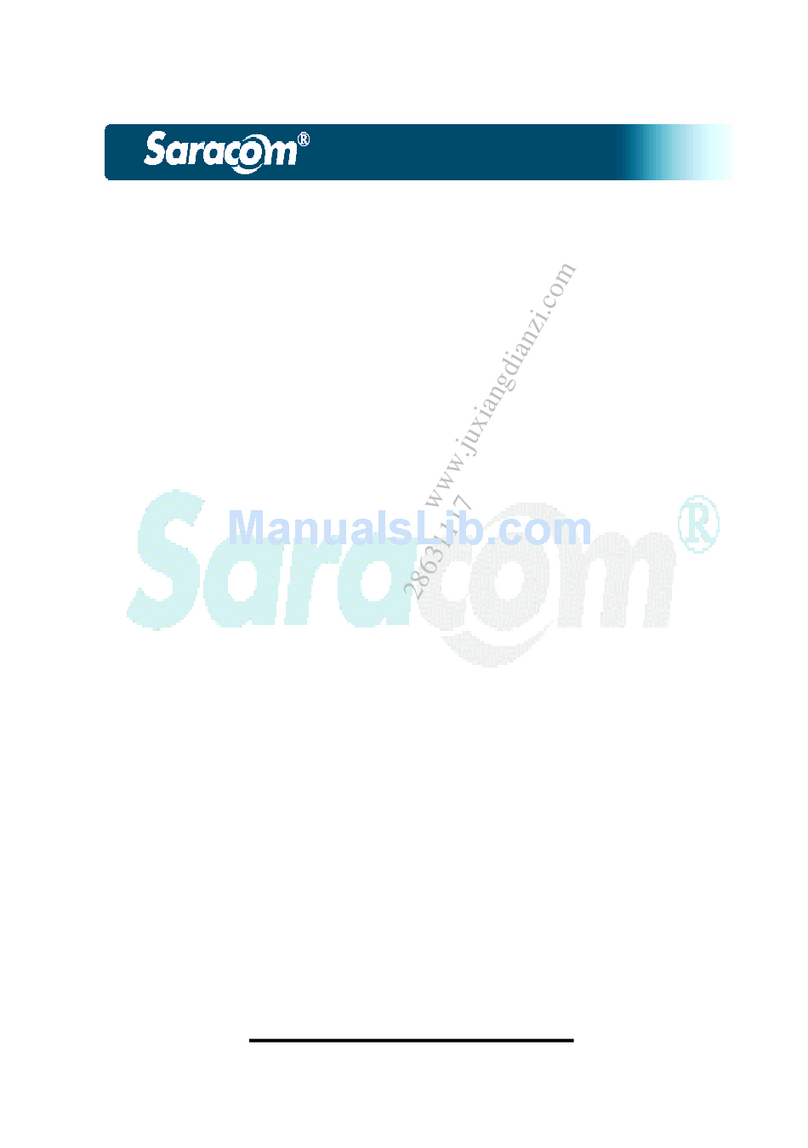
Navtex
Navtex NR-50 Operational manual

Sirius Satellite Radio
Sirius Satellite Radio Streamer Replay SIR-STRC1 user guide

PEHA
PEHA 454 FU-E REG Installation and operating instructions
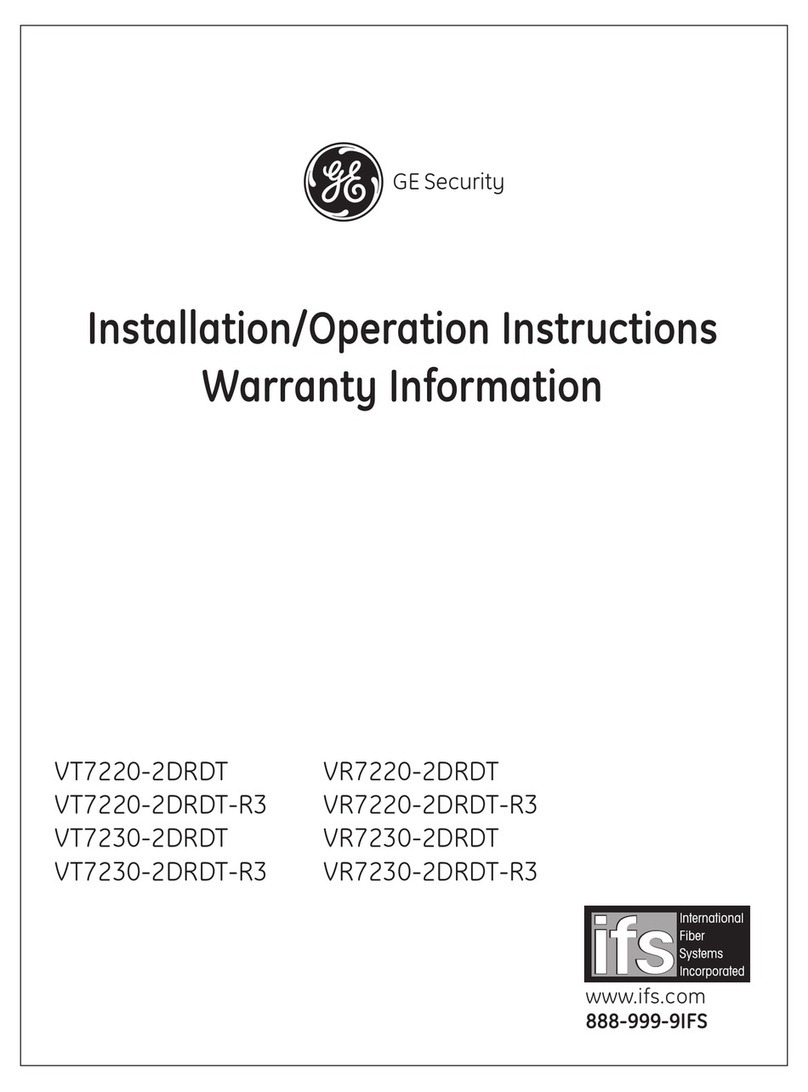
GE Security
GE Security VT7220-2DRDT Installation & operation instructions
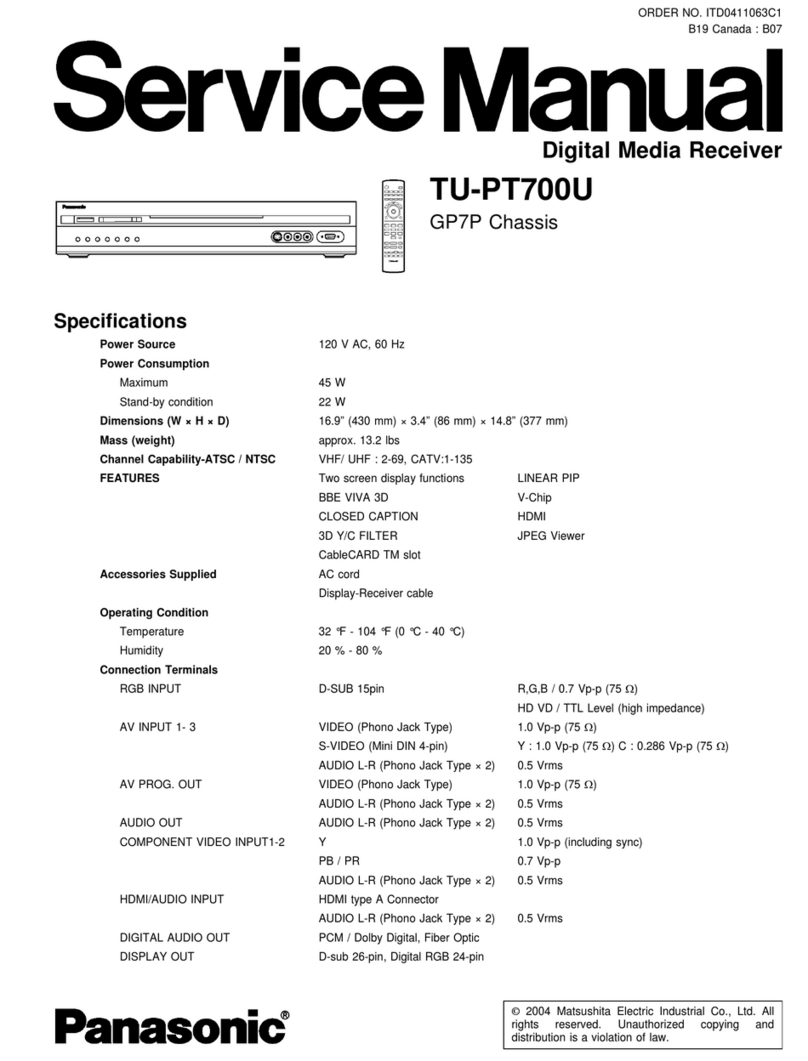
Panasonic
Panasonic TU-PT700U Service manual
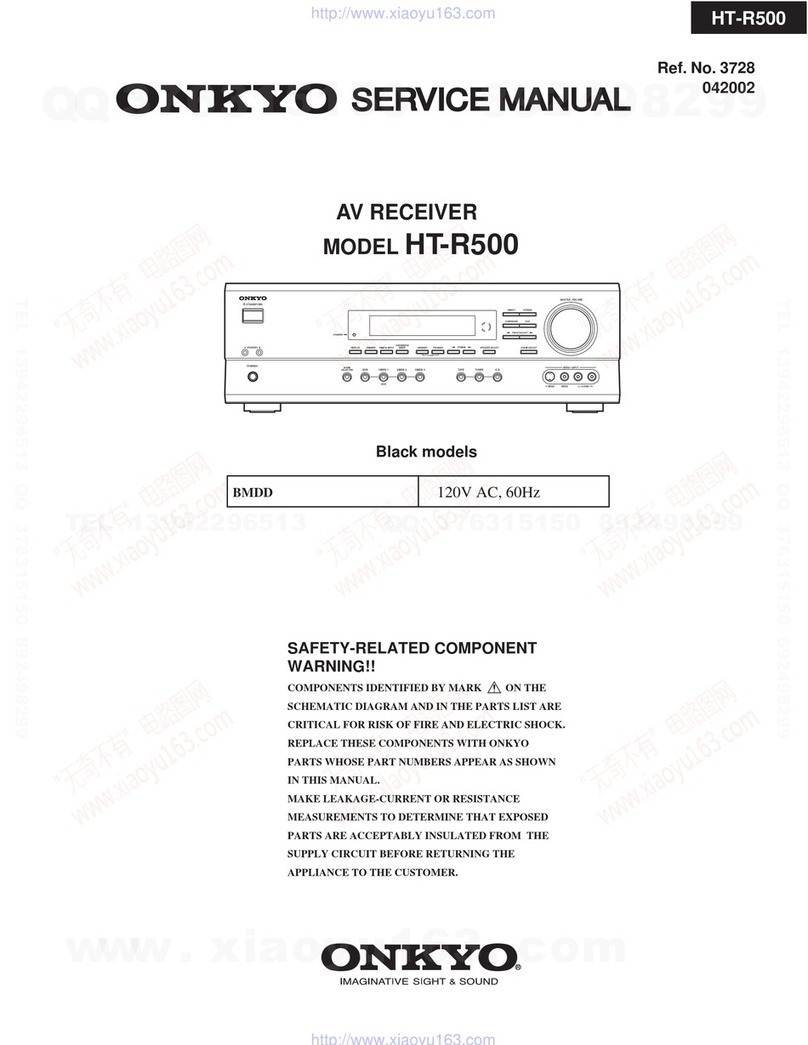
Onkyo
Onkyo HT-R500 Service manual
